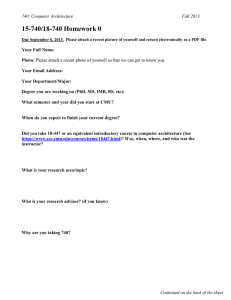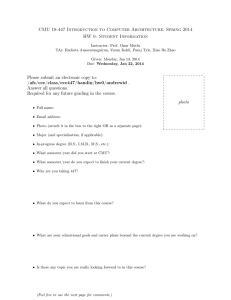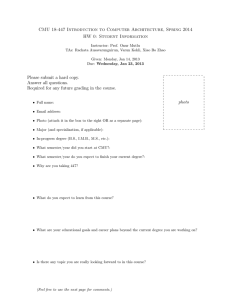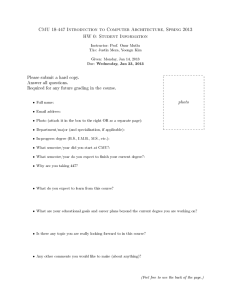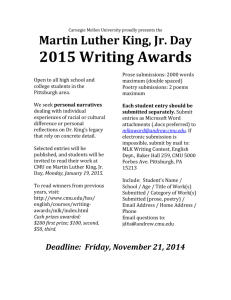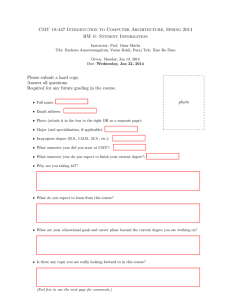Synchronization of Multi-Agent Plans
advertisement
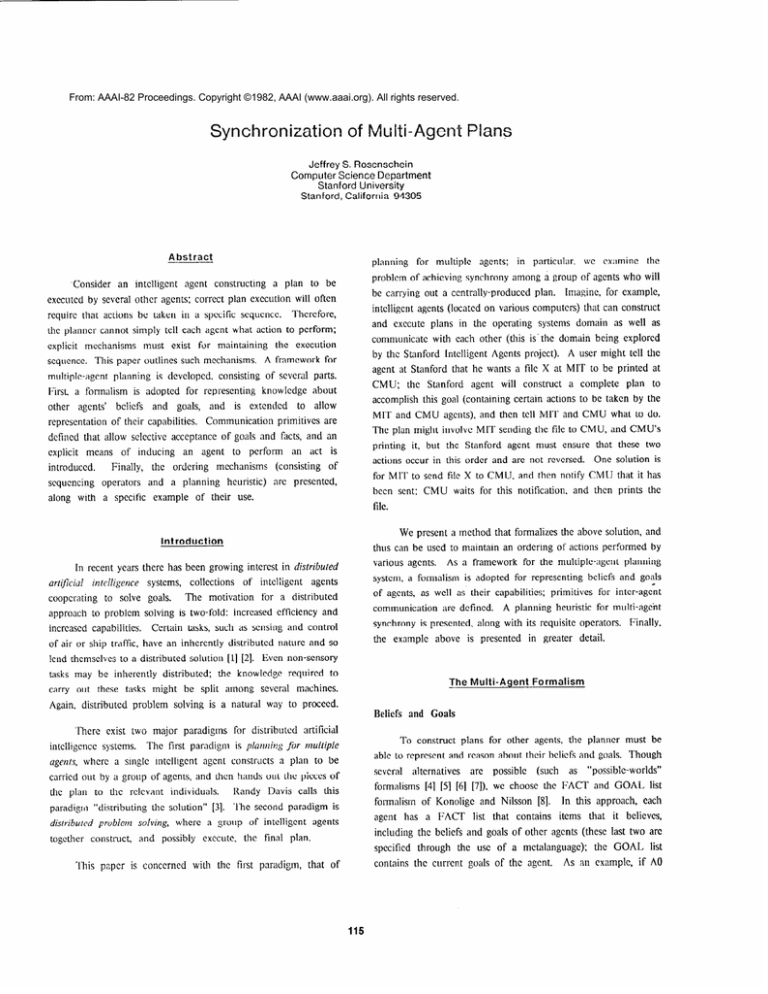
From: AAAI-82 Proceedings. Copyright ©1982, AAAI (www.aaai.org). All rights reserved. Synchronization of Multi-Agent Plans Jeffrey S. Rosenschein Computer Science Department Stanford University Stanford, California 94305 Abstract -_~ Consider an intelligent planning agent constructing a plan to be must exist for maintaining sequence. This paper outlines such mechanisms. other agents’ beliefs and goals, and representation of their capabilities. introduced. of inducing Finally, CMU; the Stanford sequencing operators mechanisms to allow and a planning heuristic) agent will construct a complete plan to MIT and CMU agents), and then tell MIT and CMU what to do. The plan might involve MIT sending the file to CMU, and CMU’s printing it, but the Stanford agent must ensure that these two an act is (consisting A user might tell the accomplish this goal (containing certain actions to be taken by the Communication primitives are the ordering Imagine, for example, agent at Stanford that he wants a file X at MIT to be printed at knowledge about an agent to perform plan. by the Stanford Intelligent Agents project). A framework for defined that allow selective acceptance of goals and facts, and an explicit means the communicate with each other (this is’the domain being explored the execution is extcndcd wc examine and execute plans in the operating systems domain as well as multiple-agent planning is devclopcd, consisting of several parts. First. a formalism is adopted for representing in particular. intelligent agents (located on various computers) that can construct Therefore, the planner cannot simply tell each agent what action to perform; explicit mechanisms agents; be carrying out a centrally-produced executed by several other agents; correct plan execution will often require that actions bc taken in a specific sequence. for multiple problem of achieving synchrony among a group of agents who will actions occur in this order and are not rcvcrsed. of One solution is for MIT to send file X to CMU, and then notify CMU that it has arc presented, been sent; CMU waits for this notification, and then prints the along with a specific example of their use. file. We present a method that formalizes the above solution, and thus can be used to maintain an ordering of actions performed by Introduction various agents. In recent years there has been growing interest in distribufed arrificial systems, inlclligeilce coopcrating collections of intclligcnt The motivation to solve goals. As a framework for the multiple-agent planning system, a formalism is adopted for representing beliefs and goals a of agents, as well as their capabilities; primitives for inter-agent agents for a distributed approach to problem solving is two-fold: increased efficiency and communication are defined. increased capabilities. synchrony is presented, along with its requisite operators. Certain tasks, such as sensing and control A planning heuristic for multi-agc’nt the example above is presented of air or ship traffic, have an inherently distributed nature and so Finally, in greater detail. lend themselves to a distributed solution [l] [2]. Even non-sensory tasks may be inherently distributed; the knowledge required to The Multi-Agent carry out these tasks might be split among several machines. Formalism Again, distributed problem solving is a natural way to proceed. Beliefs and Goals There exist two major paradigms for distributed intclligcncc systems. artilicidl To construct plans for other agents, the planner must be The first paradigm is pfaruzirlg’fur m&ple agerz/s, where a single intclligcnt agent constructs able to rcprcscnt and reason about their beliefs and goals. Though a plan to be carried out by a group of agents, and then hands out the pieces of scvcral the plan to the rclcvant individuals. formalisms [4] [5] [6] [7]), we choose the FACT and GOAL list Randy Davis calls this paradigln “distributing the solution” [3]. ‘l‘he second paradigm is distribukd problem together construct, solving, where a 3crrolip of intclligcnt agents altcrnativcs arc possible (such as formalism of Konolige and Nilsson [8]. In this approach, each agent has a FACT items that it believes, list that contains including the beliefs and goals of other agents (these last two arc and possibly exccutc, the final plan. specified through the USC of a mctalanguage); ‘I’his paper is conccrncd “possible-worlds” contains the current goals of the agent. with the first paradigm, that of 115 the GOAL list As an cxamplc, if A0 bclicvcs that Al bclicvcs Al has file FOO, and A0 also believes HASCAP(agcnt,oper) A CiOAL(agent,oper) 3 that Al has the goal of dclcting that file, the following items WILI.-PERFORM(ngcnt,oper) appear in AO’s data base: Since the fact that this axiom is universally known is also FACT(Al,‘EXIS’I’(FOO,Al)‘) known, the following axiom actually appears in every agent’s data GOAL(A;,‘DELETED(FOO)‘) base: FAC’T(x,‘HASCAP(agcnt,opcr) A GOAL(agcnt,oper) 3 All planning will make USC of STRIPS-like operators [9]. WILL-PERFORM(agent,opcr)‘) We allow instantiated operators to appear explicitly on any agent’s GO.4L list, rather than limiting this list to state descriptions. We differentiate between the two types of goals by calling the latter “operator-goals” and the former “state-goals”. This axiomatization of WILL-PFRFORM models an agent’s using an operator as an act of volition; if involuntary performance of acts is possible, WILL-PERFORM(agent,operator) could be made true without the agent actually possessing the operator as a Capabilities goal. Previous work on multiple agents has assumed that all agents have identical capabilities, that is, that all agents have access to the identical operators. When agents are planning for differing operating system environments, this is clearly not the case. For example, an agent located on one machine may be able to run TEX on a file, while the agent on another machine that lacks TEX will not. We introduce the predicate HASCAP(agent,operator) represent the capability of agent to carry out operalor. to Generality is provided by the USC of partially instantiated operators in the Other axioms would be introduced to model these cases. An agent can apply an operator once check the truth of the operator’s other preconditions make them true. WILL- becomes true; he will not necessarily PERFORM(agcnt,opcrator) or try to Given these assumptions, it is essential for the planner to ensure that WII .I,-PERFORM’s brother preconditions arc true bcforc WlI,I,-Pl~R1~Ol~M itself bccomcs true. this ordering of preconditions Achieving is identical to achieving synchrony, and will be discussccl in further detail below. HASCAP predicate. For example, if agent A0 believes that agent Al can, in general, DELETE files, the following would appear in Communication AO’s data base: Primitives ‘1’0intcgratc planning and colninllnication, WCneed to adopt HASCAP(Al,DELETE(Al,filc)) a coherent We USCthe standard convention that the free variable “file” theory of planning communication acts thcmsclvcs. The work of Cohen and Pcrrault sheds considerable light on this HASCAP is also defined over more issue, and we use several of their communication operators (with complex operator combinations; for cx~arnplc, the following axiom modification) in the work that follows. For simplicity, the initiator holds: of a communication is ufliversally quant3icd. act will be called the “speaker,” and tic receiver will be called the “hearer.” HASCAP(agcnt,AND(opcratorl,opcrator2))* HASCAP(agent,operatorl) We A HASCAP(agcnt,operator2) use four CAUSE-TO-WANT, WIIL-PEWORM and INFORM as a Prccoudition communication INFORM, are illocutionary operators: REQUEST, and CONVINCE. REQUEST acts, that is, they model the speaker’s communication act, but not the effect that act has on the Cohen and I’crrault [lo] rccognilcd the usefulness of making an hearer. agent’s “wanting” to use an operator an explicit prccondilion acts, that is, they model the effects of communication that operator. In this manner, one can get an agent to perform the precondition form, For of making the agent “want” to carry out the before the hcarcr adopts the goal, a CAUSE-‘I’O-WANT must in traduce the predicate WILL- with Konoligc and N ilsson’s single-step (as contrasted “asktoachievc” and “tell” operators). While Cohen and Pcrrault operalor. WILL-PERFORM appears as an explicit precondition of all operators that do not occur spontaneously; so, for A0 to get Al OP, A0 needs is true. This decoupling of the communication act from its cffcct will perform to signify that agenf to apply the operator occur. allows for natural modcling of goal or fact refusal by the hcnrer PERFORM(agent,operator) PERFORM(Al,OP) acts. example, the speaker might REQUEST some act of a hearer, but this will not directly cause the hearer to adopt that act as a goal; We adopt a similar strategy recast into a more general and and CONVINCE are pcrlocutionary true, including some action by making the action’s preconditions action. of CAUSE-TO-WANT to make sure WILL- The following axiom says .that if an make CAUSE-TO-WANT REQUEST and INFORM on the former operators. perform defined it: respectively, we introduce the predicates ACCEPT and BE-SWAYED as explicit preconditions agent has the capability to perform an act and has the desire to the act, then he will perform and CONVINCE trivially triggered by as follows: The communication operators zire REQUKST(u.y,act) -- x requests y to adopt act as a goal P: WILL-PI’RFORM(x,REQUEST(x,y,act)) A: FAel’(y,‘GOf~I_(x,act)‘) Ordered As explained above, the planner expects to make WILLPEIiFORM(agcnt,opcrator) The effect of REQUEST is to let y know that x has “act” as a any time. CAUSE-TO-WANT(x,y,act)--x causes y to adopt act as a goal P: FAC’l’(y,‘GO/~l,(x,act)‘) A FAC’l‘(y,‘HASCAP(y,act)‘) A ACCF,P’I’(x.y,acl) A IIASCAP(y,CAUSI:-TO-WAN’l’(x,y,act)) A: GOAL(y,act) WIIJ,-PERFORM will not bc made true, however, until agent accepts the operator-goal above axiomatization operator of WILL-PERFORM). (because of the Thus, all other preconditions of operalor should be true before the operator itself is adopted as a goal. Satisfaction of this principle will guarrantee multi-agent CAUSE-TO-WANT causes y to adopt x’s goal as its own, but only if y believes hc has the capability to satisfy the goal and the synchrony. In general, an operator-goal should not be adopted by an is true. INliORh’i(x,y,prop) true in order to get agenf to perform operator; once this predicate is true, the operator can bc applied-at goal; x need not believe a priori that y can satisfy “act.” ACCEPT prcdicatc Preconditions agent until he k~zowsthat the other preconditions of the operator -- x informs y of prop have been satisfied. To accomplish this, we introduce the P: prop ; WIl,I,-I’t~Rt~OKM(x,lNl~~l~M(x,y,prop)) predicates WAlTING and HAS-DONE, and the operators PAUSE A: I:i\C’I’(y,‘FhC’l’(x,prop)‘) and WHEN-GET, PAUSE(agcnt,precond,aim) -- agent decides to wait until precond is satisfied before adopting P: W II,1>-PERFORM(agcnt,PAUSE(agent,precond,aim)) A: FACl’(agent,‘WAITING(precond,aim)’) INFORM should only take place if prop is true; its effect is to let y know that x believes prop. defined as follows: The ‘I;” appearing in INFORM’s precondition list means that the item appearing before it should be aim satisfied before the item following it. WHEN-GET(agcnt,precond,aim) -- agent adopts aim when he knows that precond is satisfied CONVINCE(x,y,prop) -- x convinces y to believe prop P: FACT(y,‘FACT(x.prop)‘) A BE-SWAYED(x,y,prop) A HASCAP(y,CONVINCE(x,y,prop)) A: FACT(y,prop) D: FACT(y,NEGATE(prop)) P: FACT(agent,‘WAITlNG(precond,aim)’) A FAC’r(agent,prccond) A HASCAP(agent,WHEN-GET(agent,precond,aim)) A: GOAI.(agent,aim) 1): FACT(agcnt,‘WAlTING(precond,aim)’) CONVINCE causes y to adopt x’s belief as its own, but only if BE-SWAYED is true; any contradictory belief So, for example, to get agent Al to wait until agent A0 has is discarded. done act G before himself doing act H, we would pass the NT’GATE is a function over strings such that NEGATFi’x’) gives the string ‘lx’. precondition operators following operator-goal Also, note the absence of WITaL-PERFORM as a of CAUSE-TO-WANT will be applied and CONVINCE; when their preconditions these PAUSE(Al,HAS-DONE(AO,G),H). are true, wiihout any agent explicitly “wanting” them. This causes Al to place WAITlNG(HAS-DONE(AO,G),H) in its data base. When Al finds out (or more usually, is told) that Agents’ data bases contain axioms involving the ACCEPT and BE-SWAYED predicates; A0 HAS-DONE G, WHEN-GET is triggered and Al adopts H as these axioms specify conditions a goal. under which the hcarcr will accept the speaker’s facts or goals. For example, if agents A0 and Al to Al: are in a master-slave relationship, we might have the following three axioms to indicate Al’s subservience to AO’s dictates: MASTER(AO,Al) MASTER(x,y) MASTER(x,y) 3 3 FACT(agcnt,propl) ACCEPT(x,y,act) A FACT(agent,prop2) * FACT(agent,AND(propl,prop2)). BE-SWAYED(x,y,prop) Our planner employs the following heuristic to guarantee Other axioms might model Al’s willingness to ACCER multi-agent requests if his machine’s load is low, or if he owes A0 a favor; he synchrony: assume there is an operator OP with preconditions Pl through PN (some J element subset “S” of which might BE-SWAYED by A0 if he knows A0 to be reliable, or to is not already true in the initial state), and WILL-PERFORM. have particularly good information about this kind of fact (e.g. A0 The planner wants agent A0 to apply OP. Expansion of the plan will know best whether a file exists on his own machine). on Pl through PN occurs bcFore expansion of WILL-PERFORM; assume that the elements of S are made true by agent.. Al through AJ, using operators 01 through OJ respectively. 117 ‘I&en, instead of directly inducing OP’s WILL-PERFORM REQUEST and CAUSE-TO-WANT, operator-goal through a the planner satisfies it his data base (i.e. if an agent knows that everyone knows prop, then hc knows prop). through the PAUSE and WHEN-GET operators, whose “precond” Figure 1 gives the expanded variables arc instantiated as the conjunction of J elements of the form HAS-DONE(Ai,Oi), Satisfaction where of WHEN-GET’s accomplished “i” ranges second from FACT 1 to J. precondition by INFORMS and CONVINCES is of the agents satisfying S, each of whom sends their own “HAS-DONE(Ai,Oi)” message. Finally, the planner must direct each of thcsc agents to schematically). message). to acts are represented It involves getting MIT to first send the file to CMU and then inform CMU that the file has been sent. In turn, CMU is told to wait until notified that MlT has carried out the ETP-SEND, first apply Oi, and then inform A0 that they have done so (with a HAS-DONE plan that ST constructs fulfill the user’s goal (the communication and then to DOVER Construction the file. of the plan proceeds as follows: working backwards from the D-PRINTED goal, ST chooses the DOVER operator Since the operator’s preconditions to achieve it. ordered, ST expands the first precondition An Example second (WII,I,-PI~RFORM). A person using an Intelligent Agent at Stanford [ST] woild are (EXIST) before the The WII.I,-PEKF’ORM in Figure l’s left branch does not trigger the planning heuristic, since its brother like file REP.PRESS at MIT to be printed on the Dover printerat precondition “EXIS’I‘(l~EP.I’KESS,MI’I‘)” is true in the initial state. CMU. However, the WILL.-PERI;OliM The agent at Stanford knows about the following two operators (in addition to the communication and WHEN-GET operators explained operators, PAUSE the since heuristic, in the right branch dots trigger precondition, brother its “EXIS’I’(RI~P.PRI~SS.CMU)” is not initially true. above): DOVER(agcnt,filc) -- agent prints file on the Dover P: EXIST( filc,agcnt); WILL-PERFORM(agcnt,DOVER(agent,file)) A: D-PRINTED(filc,agent) I;TP-SEND(x,y,file) -- x sends file to y P: EXlST(file,x) ; WILL-PERFORM(x,FII~-SI;,ND(x,y,file)) A: EXIST(file,y) “I>OVl~l~(CILIU,IIEl~.I~l~ESS)” is not flF,QU I$1 and CAUSE-TO-WANT list (in addition to the HASCAP and WILL-PERFORM axioms listed above): to CMU by a Instead, ST plans for CMU to get this goal through the PAUSE and WHEN-GET operators; both of thcsc operators’ variables arc instantiated to 17im “I~OVf~R(CMU,Kf~f~.~Rt’,SS)“, while their ~>recorldvariables have “IiAS-I~ONE(MI’I’.E~~P-SENI~(MI’I’,CMU,KE1~.PIIESS))” as instantiation. satisfied The following items appear on the Stanford agent’s FACI passed fi.om ST. Thus, the goal WIlTIN-GET’s second FACT precondition by a mcssagc from MIT, an is thus “HAS-DONI~(MIT,ETP- In turn, MI’T is instructed to SENI~(MIT,CMU,l<Ef?PRESS))“. send this message to CMU after it has, in fact, done the FTPSEND. (1) FACT(x,‘HASCAf’(CMU,DOVER(CMU,filc))’) (2) I~AC’l’(x,‘~IASCAI’(M1’l‘,F;l’P-Sf~Nl~(Ml’I’,CMU,Tilc))‘) Acknowledgments (3) FACT(x.‘HASCAP(CMU,PAUSI<(CMU,prccond,aim))’) ‘(4) FA~l’(x,‘~l~~SCAP(CMU,WHEN-GEI’(CMU,prccond,aim))‘) The issues prcsentcd in this paper have been greatly clarified (5) FACT(/.,‘HASCAP(x,REQUEST(x,y,act))’) through many useful discussions with Mike Gcncsereth. (6) FAC’I’(z,‘HASCAP(y,CAUSE-‘rO-WhN’l’(x,y,act))’) research is supported by ONR Contract This # N00014-81-K-0303. (7) FACT(z,‘HASCAP(x,INFORM(x,y,prop))’) (8) FACT(z,‘HASCAP(y,CONVlNCE(x,y,prop))’) REFERENCES (9) EXIST(REP.PRESS,MIT) (10) FACT(x,‘MASTER(ST,CMU)‘) DI (11) FACT(x,‘MASTER(ST,MIT)‘) for Distributed (12) FACT(x,‘BE-SWAYED(MlT,CMU,prop)‘) 1,aboratory (13) FACT(z,‘MASTER(x,y) 1 ACCEPT(x,y,tict)‘) (14) FACT(z,‘MASTER(x,y) 3 BE-SWAYED(x,y,prop)‘) Axioms 1 through 8 list capabilities of the agents involved (actually, knowledge about these capabilities), with 5-8 stating that all agents have the basic communication primitives. Axioms 10 through 14 enlighten us about the hierarchy of control among the agents. Note that by the semantics of FACT, Davis, R. and R. G. Smith, “Negotiation 2s a Metaphor the axiom FACT(x,prop) in an agent’s data base implies that prop is also in Technology, PI Problem Memo Solving,” Artificial No. 624, Massachusetts Cambridge, MA (May 1981). Steeb, R., S. Cammarata, Intelligence Institute F. A. IIaycs-Roth, of P. W. Thorndykc and R. B. Wcsson, “Distributed Intelligence for Air Fleet Control,” R-2728-ARPA, Santa Monica, CA (October 1981). Rand Corporation, t31 Davis, R., “A Model for Planning Environment: 171 in a Multi-Agent Steps Toward Principles Appclt, I). E., “A Planner for Reasoning about Knowledge and Action,” Proc. of the fi’irst AmuaZ for Teamwork,” AI. Working Paper, Massachusetts Institute of Technology, American Cambridge, California, MA (June 1981). Moore, R. C., “Reasoning About Knowlcdgc and Action,” Association Confererrce Intelligence, Konolige, K. and N. J. Nilsson, “Multiple-Agent PI in Proc. ZJCAZ-5, Cambridge, Massachusetts, August, 1977, Systems,” Proc. pp. 223-227. American Association oj‘ the Stanford, of the First for Armal Artzfzcial Corlference Intelligerrce, Planning of the Stanford, August, 1980, pp. 138-141. Moor-c, R. C., “Reasoning About Knowledge and Action,” Artificial bl ArtiJicial August, 1980, pp. 131-133. California, PI for Intclligcncc Center Tcchnicnl International, Menlo Park, California hppclt, Plaming D., 191, SRI Nilsson, N. J., 191 (Menlo I.aqttage Ilttcmnces to [lo] Park: Principles of Tioga Publishing Artificial Theory of Speech Acts,” Cogilitive Science, 3 (3), pp. 177- 1981. 212 (1979). FIGURE D-PRINTED(REP.Pl?ESS,CMU) ,.k==-\ ~OVER(&h&E3~B$PRESS) ----x / WILL-PERFORM(CMU, EXlST(REP.PRESS,CMIJ) DOVER(CMU,REP.PRESS)) CL / Ad \ HASCAP(CMU, GOAL(CMU, EXIST(REP.PRESS,MIT) DOVER(CMU,REP.PRESS)) ‘DOVER(CMU,REP I PRESS)‘) .-4-Y ~ WILL-PERFC!RM(MIT, ,,-.+j-~,>y EN-GET FTP-SEND(MIT,CMU,REP.PRESS)) WILL-PERFORM(CMU,PAUSE(CMU...)) GOAL(MIT,‘FTP-SEND (MlT,CMU,REP.PRESS)‘) IMelligence, Co., 1980). Cohen, P. R. and C. R. Perrault, “Elements of a Plan-Based Goals, Ph.D. thesis, Stanford Ilnivcrsity, Safisfj, Mdti’le Dcccmbcr Natural Note (1980). GOAL(Mll‘,‘lNFORM(MIT,CMU, ‘HAS-DONIT(MIT,FTP-SEND (MlT,CMU,REP.PRESS))‘)‘) GOAL(CMU, ‘PAUSE(CMU....)‘) HASCAP(CMU, PAUSE(CMU...)) STANFORD = REQUEST and CAUSE-TO-WANT = INFORM 119 and CONVINCE 1

